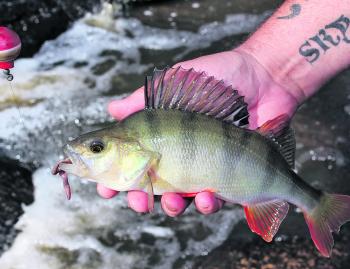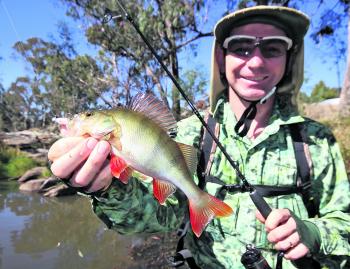What an insane autumn we have had here in North East Victoria. The Murray cod stayed active for longer than usual due to warmer than average temperatures, and when things did cool down, the trout went absolutely nuts in the hills, and a few redfin even came out to play.
It was a truly delightful autumn to go fishing in North East Victoria this year. At the end of this report, I will share a short story of a ‘myth busting’ fishing experience that I had the day before writing this report.
July is the coldest month of the year here in Victoria, but strangely enough, it is not usually the wettest. That title usually goes to May or September.
The fishing is limited in the Wangaratta area during July, however there are still a few fishing options available to anglers wanting to head out and brave the cold.
Firstly, we have the family friendly waterways that are stocked at the end of June in time for the school holidays each year. These terrific waterways usually offer easy access and often have toilet and BBQ facilities close by, promoting great family fun.
They are stocked annually with yearling rainbow trout, which are usually pan-sized, as a way to promote fishing to younger people as well as people with mobility issues. Not only do these waterways promote fishing to newcomers to the sport and give families an alternative to other more expensive holiday activities, they also give the younger people who already love fishing something to do to fill in time during the holidays.
I am a huge fan of these great little fisheries. In this area, there is Foster’s Lake at Glenrowan, Lake Sambell in Beechworth, and Stanley Dam in Stanley, the latter of which is the most popular.
In any of these waterways, the trout will be on the bite right throughout July. PowerBait often works well on these stocked trout and can be purchased at most good tackle stores. I find tiny soft plastics such as the Strike Tiger nymph quite successful, especially after I pull the claws off the soft plastic, making it a bit smaller.
Most lures will work, bladed spinners, hardbodied minnows and so on. But if you just want to catch fish, the ever-reliable bunch of garden worms will always work.
Lake William Hovell will be well worth fishing for trout during July. If it isn’t full by July, it will be close to it. There may be a few redfin kicking around in July, but it is the trout fishing that will attract most anglers to Lake William Hovell in the depths of winter. Most of the trout are small, around 30cm or under, however don’t be surprised if a monster grabs your lure or bait. Each year there are a few brown trout to 5lb that get caught. These large brown trout are not a common catch in Lake William Hovell, however there are a few around.
Trolling with winged lures is a tried and proven method in William Hovell. Small to medium sized Tassie Devils account for a lot of trout each year. My favourite colour is pink. There is actually a colour pattern named ‘pink panther’, which is my favourite.
Low light periods of the day have always been the best at Lake William Hovell, with both sunrise and sunset equally productive. Late in the afternoon, as the shadows from the towering hills to the west of the lake creep over the water, it is worth trolling along that western edge of the lake. Quite often the trout can be seen rising in the shadows, picking food of some description off the surface.
Don’t overlook small minnow type lures such as Rapalas, Pontoon21 or Wildbait either. These will also work well at low light hours.
One of my favourite trout lures in Lake William Hovell, and one that is often overlooked as a trout lure, is a small blade. Any blade will do, but I just have a personal preference for the TT switchblade in 7g, as I find they don’t tangle as often as some others. I like to cast the blade, which will cast a mile (blades are one of the best casting lures on the market), allow it to sink a little bit before beginning the retrieve. I retrieve a couple of meters, and then pause, allowing the blade to sink a bit. About nine times out of ten it is on that pause that the trout will grab the blade!
Downstream in the far lower reaches of the Ovens River, where the waters of Lake Mulwala back up there is a chance of catching a Murray cod. The cod are usually pretty slow at this time of the year, however the dedicated and serious cod anglers are usually down that way putting in the long hours, trolling large hardbodied lures around the lake and reaping the rewards for their dedication.
Sometimes these anglers might troll all day every day for 3-4 days straight, only to have one Murray cod hook-up, but they love it! The cod are down there, but be prepared to work for them.
Earlier I mentioned that I busted a myth while trout fishing recently. Here is what happened.
Growing up, I was always taught that bardi grubs were dynamite bait for Murray cod, and wood grubs were dynamite bait for trout, but white curl grubs, otherwise known as redheaded cockchafer grubs (often referred to incorrectly as witchetty grubs) were a poor bait and not worth using.
The other day, I was fishing a stream with worms, and ran out of worms, so switched to a bladed spinner. In the very last pool that I fished, I had a trout hit my lure on three consecutive casts before losing interest and ignoring it.
I turned a rock over hoping to find a worm, and found a white curl grub. So, I swapped my spinner for a hook, passed the hook through the curl grub once and cast it out, and the moment the grub passed the fish… BANG! The trout engulfed it in one swoop.
Don’t overlook the redheaded cockchafer, and if you reckon I’m leading you on, Google redheaded cockchafer and you will see what my bait looked like!
Reads: 2546
The author with another nice brown trout that he caught towards the end of the season.

Myth busted! This brown trout was caught on a Redheaded Cockchafer Grub, often incorrectly referred to as a witchetty grub – a grub that is meant to be a poor trout bait.

A nice autumn redfin caught in a tributary of the Ovens River on a bunch of worms suspended underneath a bubble float. Float fishing for redfin is great fun.





